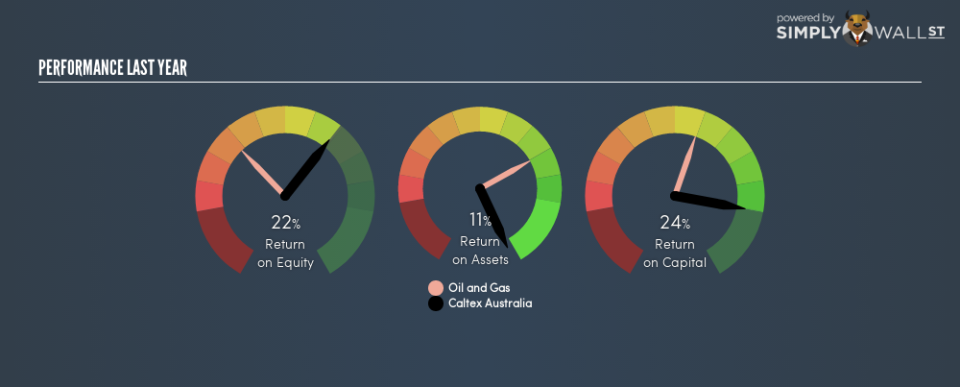What Can We Make Of Caltex Australia Limited’s (ASX:CTX) High Return On Capital?

Want to participate in a short research study? Help shape the future of investing tools and you could win a $250 gift card!
Today we are going to look at Caltex Australia Limited (ASX:CTX) to see whether it might be an attractive investment prospect. In particular, we’ll consider its Return On Capital Employed (ROCE), as that can give us insight into how profitably the company is able to employ capital in its business.
First up, we’ll look at what ROCE is and how we calculate it. Next, we’ll compare it to others in its industry. Then we’ll determine how its current liabilities are affecting its ROCE.
What is Return On Capital Employed (ROCE)?
ROCE measures the ‘return’ (pre-tax profit) a company generates from capital employed in its business. Generally speaking a higher ROCE is better. Ultimately, it is a useful but imperfect metric. Author Edwin Whiting says to be careful when comparing the ROCE of different businesses, since ‘No two businesses are exactly alike.’
So, How Do We Calculate ROCE?
The formula for calculating the return on capital employed is:
Return on Capital Employed = Earnings Before Interest and Tax (EBIT) ÷ (Total Assets – Current Liabilities)
Or for Caltex Australia:
0.24 = AU$951m ÷ (AU$7.1b – AU$2.5b) (Based on the trailing twelve months to June 2018.)
So, Caltex Australia has an ROCE of 24%.
Check out our latest analysis for Caltex Australia
Does Caltex Australia Have A Good ROCE?
One way to assess ROCE is to compare similar companies. In our analysis, Caltex Australia’s ROCE is meaningfully higher than the 6.9% average in the Oil and Gas industry. I think that’s good to see, since it implies the company is better than other companies at making the most of its capital. Regardless of the industry comparison, in absolute terms, Caltex Australia’s ROCE currently appears to be excellent.
In our analysis, Caltex Australia’s ROCE appears to be 24%, compared to 3 years ago, when its ROCE was 14%. This makes us wonder if the company is improving.
When considering ROCE, bear in mind that it reflects the past and does not necessarily predict the future. Companies in cyclical industries can be difficult to understand using ROCE, as returns typically look high during boom times, and low during busts. This is because ROCE only looks at one year, instead of considering returns across a whole cycle. We note Caltex Australia could be considered a cyclical business. Future performance is what matters, and you can see analyst predictions in our free report on analyst forecasts for the company.
Caltex Australia’s Current Liabilities And Their Impact On Its ROCE
Current liabilities are short term bills and invoices that need to be paid in 12 months or less. Due to the way ROCE is calculated, a high level of current liabilities makes a company look as though it has less capital employed, and thus can (sometimes unfairly) boost the ROCE. To counteract this, we check if a company has high current liabilities, relative to its total assets.
Caltex Australia has total liabilities of AU$2.5b and total assets of AU$7.1b. Therefore its current liabilities are equivalent to approximately 35% of its total assets. Caltex Australia has a medium level of current liabilities, boosting its ROCE somewhat.
The Bottom Line On Caltex Australia’s ROCE
Despite this, it reports a high ROCE, and may be worth investigating further. Of course, you might find a fantastic investment by looking at a few good candidates. So take a peek at this free list of companies with modest (or no) debt, trading on a P/E below 20.
If you are like me, then you will not want to miss this free list of growing companies that insiders are buying.
To help readers see past the short term volatility of the financial market, we aim to bring you a long-term focused research analysis purely driven by fundamental data. Note that our analysis does not factor in the latest price-sensitive company announcements.
The author is an independent contributor and at the time of publication had no position in the stocks mentioned. For errors that warrant correction please contact the editor at editorial-team@simplywallst.com.

